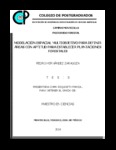Modelación espacial multiobjetivo para definir áreas con aptitud para establecer plantaciones forestales
Abstract
La selección del sitio adecuado en el establecimiento de plantaciones forestales es crucial para maximizar la probabilidad de éxito. Mediante un análisis espacial multicriterio-multiobjetivo se optimizó la selección del sitio para el establecimiento de plantaciones forestales comerciales con especies maderables y no maderables de interés en los municipios de Durango, Nombre de Dios, Súchil, Mapimí, Nazas y Rodeo del estado de Durango, México. Inicialmente, a través de evaluación multicriterio se identificaron áreas con aptitud para establecer plantaciones con cada una de las especies de interés. En una etapa posterior, mediante un proceso de análisis multiobjetivo, se optimizó la selección de los sitios de plantación para cada especie considerando varios escenarios de decisión; longitud del turno de producción, calidad de la madera, supervivencia, susceptibilidad a plagas y enfermedades, productividad de la especie y comercialización. Los resultados indican que Pinus engelmannii, P. durangensis y Acacia farnesiana presentan la mayor cantidad de áreas óptimas para establecer plantaciones forestales maderables. Agave durangensis, A. lechuguilla, Lippia berlandieri y Dasylirion sp., son las especies no maderables con la mayor adecuación óptima para establecer plantaciones en el área de estudio. La combinación de técnicas de evaluación multicriterio (AHP, WLC) y multiobjetivo (MOLA) con los sistemas de información geográfica permitieron identificar y resolver conflictos de aptitud de la tierra entre las especies de interés. _______________ SPATIAL MODELLING MULTIOBJECTIVE FOR DEFINING SUITABILITY AREAS TO ESTABLISH FOREST PLANTATIONS. ABSTRACT: The selection of a suitable site for the establishment of forest plantations is crucial to maximize their probability of success. Through a multicriteria-multiobjective spatial analysis, site selection for the establishment of forest plantations with commercial timber and non-timber species of interest in the municipalities of Durango, Nombre de Dios, Suchil, Mapimi, Nazas and Rodeo of the state of Durango, Mexico was optimized. Initially, through a multicriteria evaluation process suitable areas to establish plantations were identified for each one of the species of interest. At a later stage, through a process of multiobjective analysis, selection of sites for planting each species was optimized considering several scenarios of decision: rotation period length, quality of wood, survival, and susceptibility to pests and diseases, productivity of the species and marketing. The results indicate that Pinus engelmannii, P. durangensis and Acacia farnesiana exhibit the greatest amount of area for the optimal establishment of forest timber plantations. Agave durangensis, A. lechuguilla, Lippia berlandieri and Dasylirion sp. are the non-timber species with the most optimal matching to establish plantations in the study area. The combination of multicriteria evaluation techniques (AHP, WLC) and multiobjective (MOLA) with geographic information systems allowed to identify and resolve conflicts of land suitability between the species of interest.
Collections
- Tesis MC, MT, MP y DC [289]

